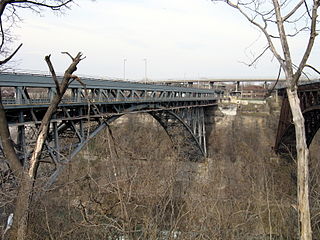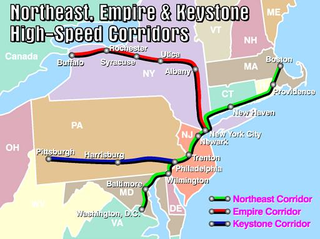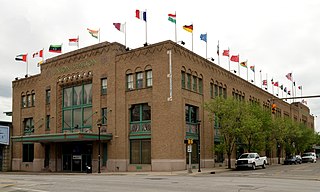
The Maple Leaf is an international passenger train service operated by Amtrak and Via Rail between Pennsylvania Station in New York City and Union Station in Toronto via the Empire Corridor. Daily service is offered in both directions; the 544-mile (875 km) trip takes approximately 12 hours, including two hours for U.S. or Canadian customs and immigration inspection at either Niagara Falls, New York, or Niagara Falls, Ontario. Although the train uses Amtrak rolling stock exclusively, the train is operated by Via Rail crews while in Canada and by Amtrak crews in the United States. Service began in 1981.

The New York Central Railroad was a railroad primarily operating in the Great Lakes and Mid-Atlantic regions of the United States. The railroad primarily connected greater New York and Boston in the east with Chicago and St. Louis in the Midwest, along with the intermediate cities of Albany, Buffalo, Cleveland, Cincinnati, Detroit, Rochester and Syracuse. New York Central was headquartered in New York City's New York Central Building, adjacent to its largest station, Grand Central Terminal.

The Empire Service is an Inter-city rail service operated by Amtrak within the state of New York in the United States. The brand name originated with the New York Central Railroad in 1967. Trains on the line provide frequent daily service along the 460-mile (740 km) Empire Corridor between New York City and Niagara Falls via Albany, the state capital.

The Lake Shore Limited is a long-distance passenger train operated by Amtrak that runs overnight between Chicago and either New York City or Boston via two sections east of Albany. The train began service in 1975; its predecessor was Amtrak's Chicago–New York Lake Shore, which operated during 1971–72. It is named for the New York Central (NYC) Lake Shore Limited, which was discontinued in 1956, and uses the NYC's former main line, part of which is now the Empire Corridor.

The Whirlpool Rapids Bridge, commonly known as the Whirlpool Bridge or the Lower Steel Arch Bridge, is a spandrel braced, riveted, two-hinged arch bridge that crosses the international border between Canada and the United States, connecting the commercial downtown districts of Niagara Falls, Ontario and Niagara Falls, New York. This bridge is located approximately 1.5 kilometres (0.9 mi) north of the Rainbow Bridge and about 2 kilometres (1.2 mi) from the Falls. It was acquired by the Niagara Falls Bridge Commission in January 1959. Immediately upstream is the similar arch-style Michigan Central Railway Bridge, which has been out of service since 2001.

The Niagara Frontier Transportation Authority (NFTA) is a New York State public-benefit corporation responsible for the public transportation oversight of Erie and Niagara counties. The NFTA, as an authority, oversees a number of subsidiaries, including the NFTA Metro bus and rail system, the Buffalo-Niagara International Airport, the Niagara Falls International Airport and NFTA Small Boat Harbor. The NFTA Metro bus and rail system is a multi-modal agency, utilizing various vehicle modes, using the brand names: NFTA Metro Bus, NFTA Metro Rail, NFTA Metrolink and NFTA PAL. In 2022, the system had a ridership of 14,061,700, or about 51,300 per weekday as of the first quarter of 2023.

The Boston and Albany Railroad was a railroad connecting Boston, Massachusetts to Albany, New York, later becoming part of the New York Central Railroad system, Conrail, and CSX Transportation. The line is currently used by CSX for freight. Passenger service is provided on the line by Amtrak, as part of their Lake Shore Limited service, and by the MBTA Commuter Rail system, which owns the section east of Worcester and operates it as its Framingham/Worcester Line.

The Empire Corridor is a 461-mile (742 km) passenger rail corridor in New York State running between Penn Station in New York City and Niagara Falls, New York. Major cities on the route include Poughkeepsie, Albany, Schenectady, Amsterdam, Utica, Syracuse, Rochester, and Buffalo. Much of the corridor was once part of the New York Central Railroad's main line.

The Michigan Central Railroad was originally incorporated in 1846 to establish rail service between Detroit, Michigan, and St. Joseph, Michigan. The railroad later operated in the states of Michigan, Indiana, and Illinois in the United States and the province of Ontario in Canada. After about 1867 the railroad was controlled by the New York Central Railroad, which later became part of Penn Central and then Conrail. After the 1998 Conrail breakup, Norfolk Southern Railway now owns much of the former Michigan Central trackage.

Buffalo Central Terminal is a historic former railroad station in Buffalo, New York. An active station from 1929 to 1979, the 17-story Art Deco style station was designed by architects Fellheimer & Wagner for the New York Central Railroad. The Central Terminal is located in the city of Buffalo's Broadway/Fillmore district. Abandoned since 1979, the terminal is now being restored for use as a Civic Commons.
The Buffalo and Niagara Falls Railroad was a part of the New York Central Railroad system, connecting Buffalo, New York to Niagara Falls. It is still used by CSX for freight and Amtrak for passenger service.

The William F. Walsh Regional Transportation Center (RTC) is an Amtrak intermodal transit station serving the Syracuse area. It is owned and operated by Intermodal Transportation Center, Inc, a subsidiary of Centro, and is also served by Greyhound Lines, Megabus, and Trailways. Local and regional bus transportation is provided by Centro. Various taxi firms provide service to the Center, as well.

The Louise M. Slaughter Rochester Station is an Amtrak intermodal transit station in Rochester, New York. Local and regional bus transportation is provided by the Rochester-Genesee Regional Transportation Authority. Various taxi firms service the station, as well. The station is located on the north side of Rochester, just east of High Falls on the south side of the tracks.

Buffalo–Exchange Street station is an Amtrak station in Buffalo, New York. The station serves six Amtrak trains daily: two daily Empire Service round trips between Niagara Falls and New York City and one Maple Leaf round trip between Toronto and New York City. There is also daily Amtrak Thruway bus service at the station, operating between the Buffalo Metropolitan Transportation Center and Jamestown station in Jamestown, New York, via Dunkirk and Fredonia, and serving the communities along the southeast shore of Lake Erie.

Since the Buffalo Metro Rail light rail was proposed in the 1970s, there have been multiple proposals for expanding the system, which is currently a single 6.4-mile (10.3 km) long line. Public officials, agencies and advocacy groups have created plans, with the most recent and formidable being an extension to the town of Amherst. One organization, the Citizens Regional Transportation Corporation (CRTC), promotes the implementation and expansions of light-rail service for the City of Buffalo and the surrounding Buffalo/Niagara region in New York State.
Transportation in New York is made up of some of the most extensive and one of the oldest transportation infrastructures in the country. Engineering difficulties because of the terrain of the State of New York and the unique issues of New York City brought on by urban crowding have had to be overcome since the state was young. Population expansion of the state generally followed the path of the early waterways, first the Hudson River and then the Erie Canal. Today, railroad lines and the New York State Thruway follow the same general route.

The Niagara Falls Station and Customhouse Interpretive Center is an intermodal transit complex in Niagara Falls, New York. It serves Amtrak trains and Niagara Frontier Transportation Authority buses, houses U.S. Customs and Border Protection offices servicing the Canada–United States border, and houses the Niagara Falls Underground Railroad Heritage Center.

Union Station is an Amtrak railroad station and mixed-use commercial building in downtown Erie, Pennsylvania, United States. It is served by the Lake Shore Limited route, which provides daily passenger service between Chicago and New York City or Boston; Erie is the train's only stop in Pennsylvania. The station's ground floor has been redeveloped into commercial spaces, including The Brewerie at Union Station, a brewpub. The building itself is privately owned by the global logistics and freight management company Logistics Plus and serves as its headquarters.

The Niagara Rainbow, known as the Empire State Express before 1976, was an American passenger train service operated by Amtrak between New York City and Detroit via Buffalo and Southwestern Ontario in Canada. The service ran between October 31, 1974, and January 31, 1979.

Transportation in Buffalo, New York is dominated by automobile use, but other modes of transportation exist in the city.





















